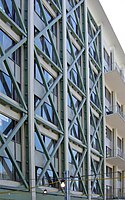
Photo from wikipedia
Abstract Different types of seismic dampers are available on the market of constructions. The more effective solutions are characterized by (i) stable and predictable response, (ii) localisation of demand into… Click to show full abstract
Abstract Different types of seismic dampers are available on the market of constructions. The more effective solutions are characterized by (i) stable and predictable response, (ii) localisation of demand into the dampers minimizing the post-earthquake damage in easily replaceable parts. Friction dampers typically satisfy both requirements. These dampers are very versatile since they can be equipped in different structural arrangements. One of the most promising solutions is their application in the moment-resisting beam-to-column joints where they can effectively dissipate the seismic energy and limit plastic deformations into easily replaceable elements. Furthermore, their resistance and deformation capacity can be easily designed without interfering with the structural geometry, thus allowing the standardisation of friction connections for a wide range of beam-to-column assemblies. The current work presents a parametric study based on finite element (FE) simulations of steel beam-to-column joints equipped with a set of five predefined friction dampers specifically conceived to cover the most representative range of profiles used in Eurocode-compliant multi-storey moment resisting frames. The FE models were calibrated against recent experimental tests performed by the authors in a former study. The analyses were aimed at extending these experimental results, investigating the local behaviour of the dampers and the connections as well as the influence of member scaling on the monotonic and hysteretic behaviour of each assembly. The results confirm that the non-linear performance of connections equipped with friction dampers is almost independent on the dimensions of the connected profiles, and it is fully replicable within a predefined range of geometries
Journal Title: Journal of Constructional Steel Research
Year Published: 2021
Link to full text (if available)
Share on Social Media: Sign Up to like & get
recommendations!